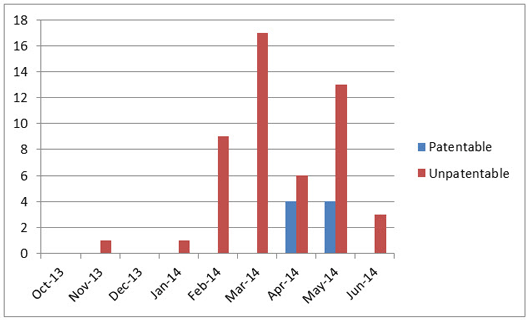The PTAB has been labeled an anti-patent "death squad" because of the high percentage of unpatentability findings in early AIA trials. Through March 2014, all 28 Final Written Decisions decided on the merits held at least one claim of the challenged patent unpatentable. Since then, the PTAB has issued eight decisions finding the patent wholly valid, helping to temper the PTAB's overall record and assuage early fears of patent owners.
At a roundtable on April 15, 2014, the Patent and Trademark Office understandably appeared defensive of the PTAB's treatment of challenged patents and emphasized statistics that included the numerous patents for which the PTAB refused to institute trials. Based in part on the discussion at the roundtable, we reported that we expected to see the allegedly pro-petitioner bent of AIA trials begin to trend back the other way. Since the roundtable, we have indeed seen that trend, as evidenced by a decrease in decisions with unpatentable findings and an increase in decisions with wholly patentable findings.
The graph below, based on data from PatentBoardFerret.com, demonstrates the latest statistics of patentable and unpatentable decisions from the PTAB.

The graph represents all Final Written Decisions under §318(a) for IPRs decided on the merits through June 10, 2014.1 Blue represents decisions where the PTAB found no patent claim invalid and red represents decisions where the PTAB found at least one claim invalid. As can be seen, no patent escaped an IPR proceeding unscathed until April; then, four decisions held all petitioned claims in the patents patentable.2 The pace of patentability continued in May, where we again saw four decisions finding all petitioned claims of the patent patentable.3
It is easy to see why many in mid-April of 2014 criticized the PTAB for killing off patents. However, because of the limited sample size of IPR Final Written Decisions on the merits and the apparent strength of early petitions, it appears that the first few months of IPR decisions may have been skewed towards unpatentability findings.
Furthermore, the Final Written Decisions decided on the merits do not represent a full picture of favorable and unfavorable rulings for patent holders. In addition to the above Final Written Decisions, there are nearly 300 cases where the PTAB denied institution of trial, the parties settled, or the patentee requested adverse judgment to cancel its claims.4 As the PTO seemed to imply at its roundtable, if we include non-instituted trials and settled trials in statistics, the results are much less pro-petitioner.
Indeed, the Final Written Decisions IPR data from April and May, particularly in context of all the closed cases, show that the PTAB may not be as challenger-friendly as previously thought.
1 Similar to statistics by the Patent Office, available at http://www.uspto.gov/ip/boards/bpai/stats/aia_statistics_05_01_2014.pdf, which twice counts a Final Written Decision that was previously joined from two instituted trials, the above graph also shows such Final Written Decisions as two.
2 IPR2013-00062, IPR2013-00282, IPR2013-00074, IPR2013-00286.
3 IPR2013-00047, IPR2013-00044, IPR2013-00043, IPR2013-00071.
4 See statistics by the Patent Office, available at http://www.uspto.gov/ip/boards/bpai/stats/aia_statistics_05_01_2014.pdf.